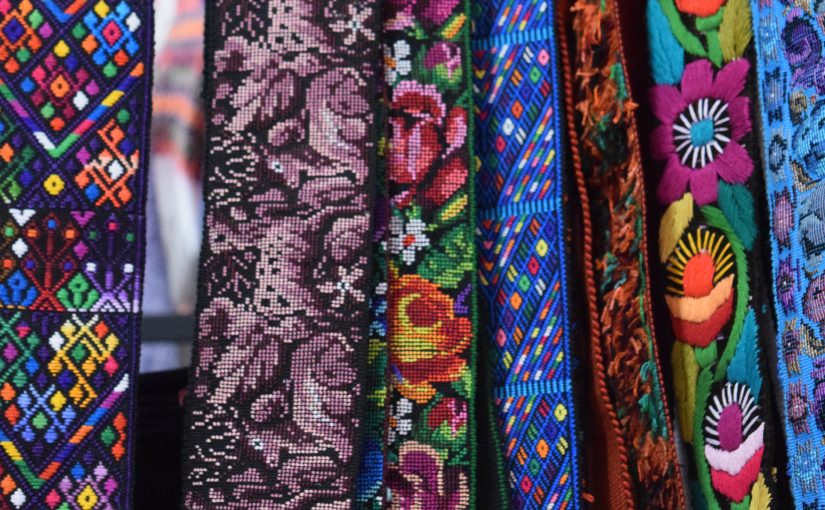In this lesson, we will learn about plural forms to reference multiple objects and people. There are several ways to pluralize words and sentences in K’iche’.
On Thursdays and Sundays, the center of Nahualá is dominated by the market. On these days, the roads are crowded with sellers and merchandise. Listen to Juan Manuel’s description of what you can find in Nahualá during market days:
 |
 |
 |
Pa wa’ we jun wachb’al ri’ kojkowinik kaqilo le k’ayb’al chi’ pa Nawalja’. E k’i le ajk’ayib’: E k’o le ajk’ay taq pix, e k’o le ajk’ay taq ichaj, e k’o le ajk’ay taq kaqa q’oq’, e k’o le ajk’ay taq atz’yaq, e k’o le ajk’ay taq xajab’. Kaqilo chuqe’ cher e k’o ixoqib’, e k’o achijab’, e k’o ak’alab’, e k’o k’ajolab’ cher are la’ e loq’omanelab’. Pa le k’ay’b’al e k’i le ajchakib’ ma k’i taq uwach le k’ayij. Aretaq katani’ le k’ayb’al, le a’jchakib’ kakik’ol le kik’ay pa taq le nimaq taq ja wokotal chunaqaj le uk’u’x tinamit. K’a te k’u ri’, le e tz’i’ kakimajij wa’katem pa le k’ayb’al che utzukuxik kiwa pa taq le k’olb’al mes. K’a te keb’ek aretaq kajosq’itaj le k’ayb’al.
In this photograph we can see the Nahualá market. There are many sellers: There are tomato vendors, there are vegetable vendors, there are watermelon vendors, there are clothes vendors, there are shoe vendors. We also see that there are women, men, children, and young people as the buyers. At the market, there are many workers because there are many kinds of goods being sold. When the market closes, workers store their merchandise in big houses built near the center of town. Afterwards, dogs start walking around the market, looking for food in the trash receptacles. They don’t leave until the whole market is clean.
Nouns
Plural nouns are marked with the suffix –Vb’, where V = Vowel. If the last vowel of the noun is –i or –e, the plural suffix is –ab’:
Note that a’re “they” is the plural of are “he/she”. When appearing as predicates of third person plural subjects, plural nouns require an agreement proclitic e (as in e tijoxelab’ “students” in Ex. 2).
If the last vowel of the noun is –a, -o, -u, the plural suffix is –ib’:
If the noun begins with a vowel, the proclitic e that marks plurality becomes a glottal stop inserted after the first vowel of the third person plural noun (a’jchakib’).
There are some exceptions to the vowel rule above. In almost of all of them, however, the meanings of the plural form are somewhat different from the singular:
Adjectives
Adjectives do not have plural forms except the following (the plural suffix is -aq)
When the adjective is acting as sentence predicate, a glottal stop is required after the ‘a’ in –aq.
For a more in-depth explanation of adjectives see lessons 28 and 29.
Proclitic particle ‘taq’
Plural nouns are marked with the proclitic taq.
b) In existential and stative sentences: When the predicate is a plural noun, the particle taq precedes the article. The reader should be aware that in K’iche’ predicates precede subjects unlike Spanish or English.
In Ex. 20, the predicate saq “white” precedes the subject taq le ja “the houses”.
When referencing animate nouns the agreement marker e before the predicate is preferred as in Ex. 22.
In example 23, the proclitic e is the sole plural marker as the proclitic taq does not appear preceding the subject le tz’i’ “the dogs.”
In like fashion, in example 24, the proclitic e before the predicate utz is the only plural marker.
In Ex. 25 both the predicate nima’q and the subject altomab’ bear plural markers.
In example 26, the agreement proclitic e precedes wal “my kids.” Note the plural marking on the pronoun a’re “they.”
Note the agreement proclitics (e and glottal stop) on both plural nouns in the predicate e tijoxelab’ and in the subject le a’chijab’.
In contrast to Ex. 28, the subject achijab’ does not show proclitic agreement in Ex. 29.
In existential sentences the proclitic e precedes the existential k’o as in Ex. 31. The cardinal number kajib’ “four” marks the subject as plural. Possessed nouns such as uk’ajol “his sons” are not pluralized.
Finally, there is an additional proclitic particle with a diminutive, affective connotation that indicates affection or appreciation towards the subject: staq, as in Ex. 33 below. Do not confuse this with taq, which is a distributive/diminutive as well (Ex. 34).
| jun | one |
| keb’ | two |
| oxib’ | three |
| kajib’ | four |
| jo’ob’ | five |
| waqib’ | six |
| wuqub’ | seven |
| wajxaqib’ | eight |
| b’elejeb’ | nine |
| lajuj | ten |
| pix | tomato |
| ichaj | herbs |
| kaqa q’oq’ | watermelon |
| q’an (inkine’y, prut) | banana |
| saqwach | potato |
| saqmo’l | egg |
| kinaq’ | bean |
Transform the following sentences into plural, then translate them into English:
- K’o jun ajk’ay prut pa le k’ayb’al.
- K’o jun tz’i’ pa le b’e.
- La k’o le awuj? Je’, k’o nuwuj.
- Ajk’ay pix le wachi’il.
- K’o jun achi pa le k’ayb’al.

